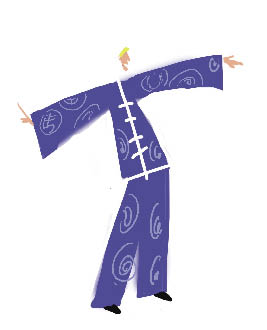Shopping
Grammar
能愿动词
Modal Verbs
Modal verbs such as 想 (want to), 要 (want), 会 (can), 能 (can) and 可以 (may) are often put before verbs to show will, capability or possibility.
The negative forms of these verbs are formed by putting 不 (no/not) before them.
For example:
Declarative form Negative form
我想买毛衣。 我不想买毛衣。
I want to buy a sweater. I don't want to buy a sweater.
你可以试穿。 你不可以试穿。
You can try it on. You can't try it on.
Exercises
Fill in the blanks with “能”、“会”、“可以”.
Example:
马克__说中文。
Mǎkè __shuō Zhōngwén.
马克会说中文。
1. 这里不 __ 吸烟。
Zhèlǐ bù __ xīyān.

2. 珍妮__做中餐。
Zhēnní __zuò Zhōngcān.
3. 他生病了,不__去上课。
Tā shēngbìng le, bù __qù shàngkè.
Reading
唐装的款式起源于清朝末期。过去,只有王公贵族才能穿着。但现在,它已经成为深受普通百姓喜欢的一种服装。唐装有多种颜色,最常见的是红色、深蓝色还有金色。 唐装上还常绣有表示吉祥如意的汉字作为图案,如“福”、“寿”等等。
Tángzhuāng de kuǎnshì qǐyuán yú Qīngcháo mòqī. Guòqù, zhǐyǒu wánggōng guìzú cáinéng chuānzhuó. Dàn xiànzài, tā yǐjīng chéngwéi shēnshòu pǔtōng bǎixìng xǐhuan de yìzhǒng fúzhuāng. Tángzhuāng yǒu duōzhǒng yánsè, zuì chángjiàn de shì hóngsè、shēnlánsè háiyǒu jīnsè. Tángzhuāng shàng hái cháng xiù yǒu biǎoshì jíxiángrúyì de Hànzì zuòwéi tú’àn, rú “fú”、 “shòu” děngděng.
Translation
The Tang suit originated at the end of the Qing Dynasty (1644-1911). At that time, it was only worn by the aristocracy. However, in modern times it has become popular among the average person. Tang suits come in different colors, most commonly red, dark blue and gold. One common design theme is to embroider Chinese characters with auspicious meanings such as happiness or longevity on them.

